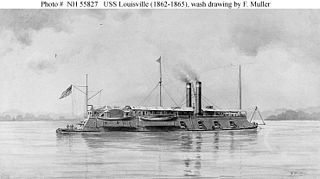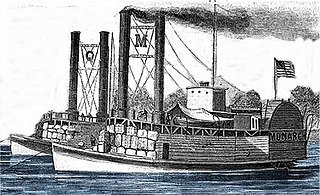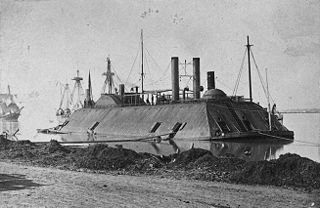Related Research Articles

USS Essex was a 1000-ton ironclad river gunboat of the United States Army and later United States Navy during the American Civil War. It was named by her captain, William Porter, for his father's old sailing frigate, the USS Essex. This Essex was originally constructed in 1856 at New Albany, Indiana as a steam-powered ferry named New Era.

USS Tyler was originally a merchant steamboat named A. O. Tyler, a commercial side-wheel steamboat with twin stacks and covered paddles positioned aft. Constructed in Cincinnati, Ohio in 1857, it was acquired by the United States Navy, 5 June 1861 for service in the American Civil War and converted into the gunboat USS Tyler on 5 June 1861. She was commissioned in September 1861. She was protected with thick wooden bulwarks.

The third USS Lexington was a timberclad gunboat in the United States Navy during the American Civil War.

USS Carondelet (1861) was a City-class ironclad gunboat constructed for the War Department by James B. Eads during the American Civil War. It was named for the town where it was built, Carondelet, Missouri.
The first USS Undine was a "tinclad" steamer in the United States Navy in 1864, during the American Civil War. She was captured on 30 October and put in service with the Confederates, but was not renamed before being burned, 5 days later, to prevent re-capture.

USS Louisville was a City-class ironclad gunboat constructed for the U.S. Army by James B. Eads during the American Civil War.

The first USS Tuscumbia was a gunboat in the United States Navy during the American Civil War. She was named for the town of Tuscumbia, Alabama, which had been named for a Cherokee chief.

Laurent Millaudon was a wooden side-wheel river steamboat launched at Cincinnati, Ohio, in 1856 operating in the New Orleans, Louisiana, area, and captained by W. S. Whann. At the beginning of the American Civil War she was taken into service by the Confederate Navy as CSS General Sterling Price. On 6 June 1862, she was sunk at the First Battle of Memphis. She was raised and repaired by the Union army, and on 16 June 1862 was moved into Union service as USS General Price and served until the end of the war.

USS Baron DeKalb was a City-class ironclad gunboat constructed for the Union Navy by James B. Eads during the American Civil War.

USS Monarch was a United States Army sidewheel ram that saw service in the American Civil War as part of the United States Ram Fleet and the Mississippi Marine Brigade. She operated on the Mississippi River and Yazoo River during 1862 and 1863.
CSS Jackson was a gunboat of the Confederate Navy during the American Civil War.

USS Mound City was a City-class ironclad gunboat built for service on the Mississippi River and its tributaries in the American Civil War. Originally commissioned as part of the Union Army's Western Gunboat Flotilla, she remained in that service until October 1862. Then the flotilla was transferred to the Navy and she became part of the Mississippi River Squadron, where she remained until the end of the war.

Fairplay was a wooden riverine ship in the United States Navy during the American Civil War.

USS Sagamore was a Unadilla-class gunboat built on behalf of the United States Navy for service during the American Civil War. She was outfitted as a gunboat and assigned to the Union blockade of the Confederate States of America. Sagamore was very active during the war, and served the Union both as a patrol ship and a bombardment vessel.
USS Curlew was a Union Navy stern-wheel steamer that saw service during the American Civil War. Built in 1862 in Pennsylvania as a civilian vessel, she was purchased by the Union Navy on December 17, 1862. Converted into a tinclad gunboat, she saw service from 1863 to 1865, often serving on the Mississippi River, the Ohio River, and the Tennessee River. In May 1863, she was involved in a minor action against Confederate forces on the Mississippi River off of the shore of Arkansas. July saw Curlew take part in an expedition up the Red River of the South, the Tensas River, the Black River, and the Ouachita River that captured two steamers and destroyed two more and a sawmill. On May 24, 1864, she dueled with Pratt's Texas Battery while on the Mississippi River, and on November 4 of that same year, was near the action of the Battle of Johnsonville but was unable to join the fighting. Decommissioned on June 5, 1865, she was sold in mid-August and her further career is unknown.

USS Calhoun was a captured Confederate steamer and blockade runner acquired by the Union Navy from the prize court during the American Civil War.
USS Exchange was a steamer acquired by the Union Navy during the American Civil War.

The Pook Turtles, or City-class gunboats to use their semi-official name, were war vessels intended for service on the Mississippi River during the American Civil War. They were also sometimes referred to as "Eads gunboats." The labels are applied to seven vessels of uniform design built from the keel up in Carondelet, Missouri shipyards owned by James Buchanan Eads. Eads was a wealthy St. Louis industrialist who risked his fortune in support of the Union.

The Battle of Lucas Bend took place on January 11, 1862, near Lucas Bend, four miles north of Columbus on Mississippi River in Kentucky as it lay at the time of the American Civil War. In the network of the Mississippi, Tennessee and Ohio rivers, the Union river gunboats under Flag Officer Andrew Hull Foote and General Ulysses S. Grant sought to infiltrate and attack the Confederate positions in Tennessee. On the day of the battle, the Union ironclads Essex and St Louis, transporting troops down the Mississippi in fog, engaged the Confederate cotton clad warships General Polk, Ivy and Jackson and the gun platform New Orleans at a curve known as Lucas Bend in Kentucky. The Essex, under Commander William D. Porter, and the St Louis forced the Confederate ships to fall back after an hour of skirmishing during which the Union commander was wounded. They retreated to the safety of a nearby Confederate battery at Columbus, where the Union vessels could not follow.
USS Romeo was a sternwheel steamer that saw service as a tinclad warship during the American Civil War. Completed in August 1862 for civilian trade on the Wabash River, she was instead purchased by the Union Navy for military service in October. Commissioned in December, she cleared naval mines on the Yazoo River later that month before participating in the operations against Confederate-held Fort Hindman in January 1863. After the fall of Fort Hindman, Romeo was part of an expedition up the White River. In February and March 1863, she was part of the Yazoo Pass Expedition, and she fought with Confederates at river landings later in the year to help isolate Vicksburg, Mississippi, during the Vicksburg campaign.
References
 This article incorporates text from the public domain Dictionary of American Naval Fighting Ships .
This article incorporates text from the public domain Dictionary of American Naval Fighting Ships .